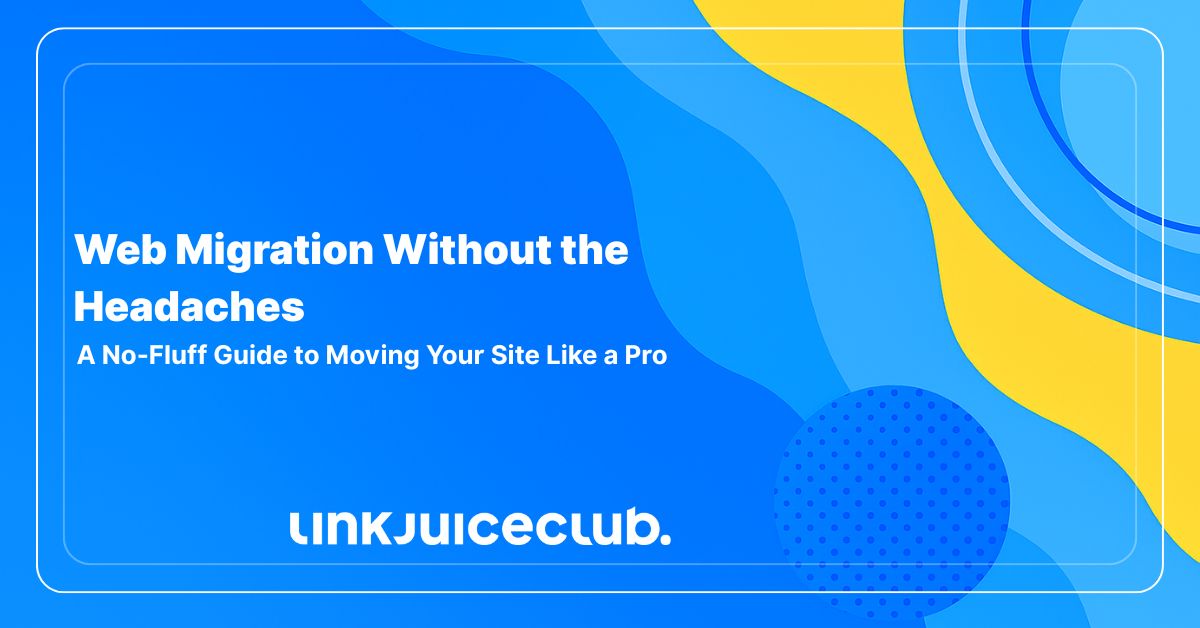
Web Migration Without the Headaches: A No-Fluff Guide to Moving Your Site Like a Pro
Think moving day is tough? Try migrating your entire website — broken links, botched redirects, and vanished traffic are just a few of the ghosts that can come back to haunt you. But here’s the twist: Web migration doesn’t have to feel like digital demolition.
Whether you’re rebranding, switching platforms, or giving your old site a facelift, the way you handle your move can make or break your rankings. And if you think Google will just “figure it out”… oh no, friend. That’s how SEO horror stories begin.

In this guide, we’ll break down how to pull off a smooth web migration without sacrificing your search visibility, losing sleep, or tanking your traffic. Ready to migrate like a master? Let’s get your digital house in order. 🧹💻
Don’t Trash the Treasure: Why Your Old Site Still Matters
Web migrations usually come at the end of a shiny redesign — fresh visuals, better UX, maybe even a whole new brand vibe. But here’s the trap: in the excitement of building the new, folks often forget to protect what’s already working.
👉 Your current site isn’t just a placeholder. It’s packed with value — and leaving it behind without a plan is like tossing out gold with yesterday’s trash.
Here’s what’s at stake:
- 🔍 Keyword rankings you’ve already earned
- 📈 Traffic that converts — not just clicks, but sales, signups, and engagement
- 💸 Revenue drivers and historical performance data
- 🔗 Hard-won backlinks that fuel your authority
Redesigns are great — but without a web migration strategy, you’re putting all of that at risk. The goal? Audit everything and build your new site like a vault that protects what matters most.
Because this isn’t just a glow-up. It’s a digital legacy you’re moving.
Redirect Roulette: Why Sloppy URL Chains Sink Migrations
When you change a site’s structure, your URLs usually don’t make it out untouched. Some get moved, some get renamed, others get retired. And in the chaos, it’s easy to let redirects pile up like a digital game of Jenga.
But here’s the thing: Messy redirects aren’t just untidy — they’re dangerous.
Here’s why you need to clean house:
- 🐌 Google taps out after 5 redirect hops — anything more, and it stops crawling
- 🖥️ Long chains = slower server response, hurting speed (and rankings)
- 🔁 Redirect loops stress servers and frustrate users
- 🚫 302s in the chain? Say goodbye to proper indexation
Web migrations are the perfect time to do a URL detox. Audit your existing redirects, flatten the chains, and keep things fast, clean, and crawlable.
Clean redirects = clean performance. Don’t let URL baggage drag your new site down.
Did You Loop In SEO… or Just Assume?
Designs are dazzling, wireframes are flying, devs are deep in code — and somewhere in the corner, SEO is sipping cold coffee, wondering why no one invited them to the web migration party.
Big mistake.
SEO isn’t just the “redirect person.” They’re your navigator — the one who keeps your shiny new site from driving straight into a search visibility ditch.
Here’s where SEO needs a seat at the table from day one:
- 🗺️ Sitemaps: Structure affects crawlability. Miss it now, regret it later.
- 📐 Wireframes: Layout decisions can make or break content visibility.
- 📝 Copy & creative briefs: SEO ensures your voice reaches both people and algorithms.
Waiting until launch to involve SEO is like proofreading after printing — expensive, stressful, and often too late.
Skip this step, and you risk launching a pretty site that tanks your traffic. And guess what? A pretty site with no visitors is just digital art.
Analytics Isn’t a “Later” Job — It’s a Launch Essential
Everyone loves a good performance report after a web migration. But here’s the curveball: You can’t track what you forgot to tag.
Too often, brands remember to analyze, but forget to implement — or worse, they rework event names and categories so much that pre- and post-migration data might as well be apples and oranges.
Want clean comparisons and actionable insights? You’ll need more than just Google Analytics turned on.
Here’s how to keep your data story straight:
- 🏷️ Stick to consistent event names across old and new versions
- 🧪 Use a staging environment to validate tracking before go-live
- 🔁 Retain key tags wherever possible — especially for conversions
Good analytics starts before launch day. If it’s an afterthought, your reporting will be, too — and you’ll be flying blind when it matters most.
Before You Hit Launch: Save the Value, Skip the Regrets
We’ve seen web migrations in every shape and size — from multilingual giants to scrappy startups. And if there’s one pattern that never fails? The smallest oversights often cause the biggest headaches.
If this guide helped surface anything you hadn’t considered, that’s the point. A successful web migration isn’t just about moving pages — it’s about preserving what’s already working while setting the stage for what’s next.
Because in the world of SEO, momentum is everything, and a smooth migration means you don’t have to start from zero.





